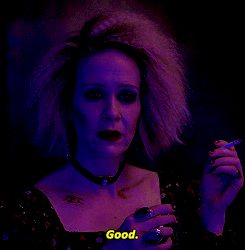Gore and Glamour: Versace, an American Horror Story.
- Lizbette Ocasio-Russe
- Apr 6, 2020
- 4 min read

American Horror Story’s Ryan Murphy apparently just couldn’t help himself with The Assassination of Gianni Versace: American Crime Story. The color palettes, music, writing style, and plot development are all insanely reminiscent of American Horror Story's style, particularly that of Coven (S3), Freak Show (S4), Hotel (S5), Apocalypse (S8), and 1984 (S9).

Of course, Murphy was not the only one responsible for the series’ aesthetic; although, I suspect he weighed in heavily not only as executive producer, but also as the director of the season premier.
The 9-episode limited series is based on Vulgar Favors: Andrew Cunanan, Gianni Versace, and the Largest Failed Manhunt in U.S. History by on Maureen Orth. In addition to having the same sound, look, and feel as many AHS seasons, the series also made use of some of AHS’s newest cast additions: Cody Fern and Finn Wittrock. Fern made his debut in AHS: Apocalypse as the anti-Christ, Michael Langdon, and returned in AHS: 1984 as Xavier Plympton, a superficial aspiring actor.

Finn Wittrock made his first appearance in AHS: Freak Show as the creepy sociopath Dandy Mott; it’s worth noting that Dandy is one of the most horrific characters developed by AHS. He is wildly different from any of the characters that came before him with his literal embodiment of the dandy, a superficial man whose priority is to be elegant, sophisticated, and cultured; for the dandy, it’s all about leisure, indifference, and the primacy of the self.

France and Britain were known for dandy culture, but the dandy also exists as a prominent literary figure. In discussing the dandy, Charles Baudelaire states that “money is indispensable to those who make a cult of their own emotions” (687); thus, the dandy is usually portrayed as a wealthy individual. Baudelaire continues, “It is the joy of astonishing others, and the proud satisfaction of never oneself being astonished. A dandy may be blasé, he may even suffer; but in this case, he will smile like a Spartan boy under the fox’s tooth” (687). This is a perfect description of AHS’s Dandy who is always eerily polite and well-mannered when he is contemplating murder or in severe danger. Similar characters you may have come across include Paul, the extremely polite home invader from Michael Haneke’s Funny Games (2007), and the “Polite Stranger” from James DeMonaco’s The Purge (2013).

Unfortunately, Wittrock’s participation in The Assassination of Gianni Versace was short lived, as he only made a special guest appearance as Jeff Trail. Fern, on the other hand, had a recurring role as David Madson. Luckily, both did a fantastic job portraying their respective characters, and their chemistry with Darren Criss, who plays Andrew Cunanan, was on point. Without some knowledge on the dandy, it would be very difficult to fully understand Criss’ interpretation of Cunanan, the protagonist of the series and murderer of Gianni Versace, because Cunanan is represented as a frustrated dandy who lacks the means to support the leisurely and sophisticated lifestyle he so desperately desires. It is thus no surprise that Cunanan turns to crime to support his aspiring dandyism, which he only ever achieves momentarily.

Murphy clearly saw the potential to turn Cunanan’s bizarre story into a highly dramatic crime story à la American Horror Story; the 80s/90s Miami gay scene and fashion scenes are perfectly suited to the style Murphy established in both AHS and Scream Queens, both of which he created alongside Brad Falchuck.

Glamour and gore seem to be Murphy’s thing, and that’s exactly what we get in The Assassination of Gianni Versace. Cunanan’s character definitely has a Chanel Oberlin/mean girl quality to him, which contrasts nicely with Gianni Versace’s character which is portrayed as authentic and genuine, despite his lavish and privileged lifestyle. Thus, Cunanan is a frustrated, sociopathic murderer with dreams of dandyism.
Murphy had already flexed his mean girl/80s/horror muscles with AHS and Scream Queens, both of which make use of contemporary settings and retro-chic music set to the tone of a flirty neon color palette, by the time he did The Assassination of Gianni Versace. So it's not surprising to find similarities between them; that is not to say that The Assassination of Gianni Versace is purely derivative, only that Murphy used some of the same basic elements from AHS and Scream Queens in the series and thus perhaps inadvertently created a trifecta of series all of which share the same general aesthetic and tone. In a way, Murphy is a television auteur; that is, like directors in the film industry considered auteurs which have a very clear style that is evident in a number of their films, Murphy has a clear style that is evident in a number of his tv series.
Another winning quality of the series is the surprise reveal at the end. The motivation behind Versace’s murder is not revealed until the very end. Although Cunanan has a lengthy record of murder, his intention with Versace is presented as being somehow different than his intentions with the other men he killed. Of course, Cunanan attempts to seduce Versace, as he does the other men, but fails to do so. Versace wishes to inspire Andrew, not mentor him or keep him as a romantic partner; this is what sends Cunanan off the rails.

The series does a good job of showing how Cunanan became the person that ended up killing five men and committing suicide; it mostly has to do with his family, especially his father, and his deteriorating mental state. Thanks to the series' exploration of Cunanan's past and psyche, it can certainly be considered a psychological thriller and thus be enjoyed on that basis alone. Even if you’re not a Ryan Murphy fan, the series is worth a watch if only to learn about one of the most infamous American horror stories.
Works Cited:
Leitch, Vincent B. et al., editors. The Norton Anthology of Theory and Criticism. 2nd ed., W.W.
Norton & Company,2010.






Comments